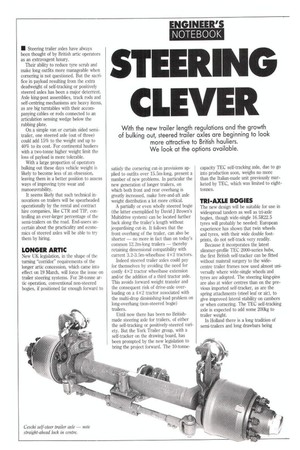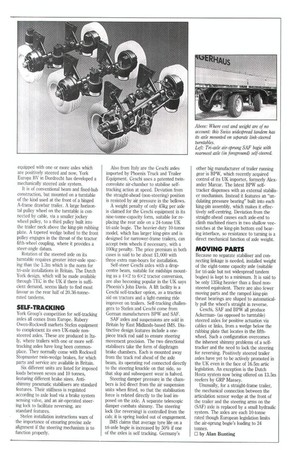STEERING CLEVER With the new trailer length regulations and the
Page 34

Page 35

If you've noticed an error in this article please click here to report it so we can fix it.
growth of bulking out, steered trailer axles are beginning to look more attractive to British hauliers. We look at the options available. MI Steering trailer axles have always been thought of by British artic operators as an extravagent luxury.
Their ability to reduce tyre scrub and make long outfits more manageable when cornering is not questioned. But the sacrifice in payload resulting from the extra deadweight of self-tracking or positively steered axles has been a major deterrent. Axle king-post assemblies, track rods and self-centring mechanisms are heavy items, as are big turntables with their accompanying cables or rods connected to an articulation sensing wedge below the rubbing plate.
On a simple van or curtain sided semitrailer, one steered axle (out of three) could add 15% to the weight and up to 40% to its cost. For continental hauliers with a two-tonne higher weight limit the loss of payload is more tolerable.
With a large proportion of operators bulking out these days vehicle weight is likely to become less of an obsession, leaving them in a better position to assess ways of improving tyre wear and manoeuvrability.
It seems likely that such technical innovations on trailers will be spearheaded operationally by the rental and contract hire companies, like CTR and TIP, controlling an ever-larger percentage of the semi-trailers on the road_ End-users uncertain about the practicality and economics of steered axles will be able to try them by hiring.
LONGER ARTIC New Uh legislation, in the shape of the turning "corridor" requirements of the longer artic concession, which came into effect on 19 March, will force the issue on trailer steering systems. For 38-tonne artic operation, conventional non-steered bogies, if positioned far enough forward to satisfy the cornering cut-in provisions applied to outfits over 15.5m-long, present a number of new problems. In particular the new generation of longer trailers, on which both front and rear overhang is greatly increased, make fore-and-aft axle weight distribution a lot more critical.
A partially or even wholly steered bogie (the latter exemplified by David J Brown's Multidrive system) can be located further back along the trailer's length without jeopardising cut-in. It follows that the front overhang of the trailer, can also be shorter — no more in fact than on today's common 12.2m-long trailers — thereby retaining dimensional compatibility with current 3.2-3.5m-wheelbase 4 x 2 tractors.
Indeed steered trailer axles could pay for themselves by avoiding the need for costly 4x2 tractor wheelbase extension and/or the addition of a third tractor axle. This avoids forward weight transfer and the consequent risk of drive-axle overloading on a 4 x2 tractor associated with the multi-drop diminishing-load problem on long-overhang (non-steered bogie) trailers.
Until now there has been no Britishmade steering axle for trailers, of either the self-tracking or positively-steered variety. But the York Trailer group, with a self-tracker on the drawing board, has been prompted by the new legislation to bring the project forward. The 10-tonne capacity TEC self-tracking axle, due to go into production soon, weighs no more than the Italian-made unit previously marketed by TEC, which was limited to eighttonnes.
TRI-AXLE BOGIES The new design will be suitable for use in widespread tandem as well as tri-axle bogies, though wide-single 16.5R22.5 tyres will probably be needed: European experience has shown that twin wheels and tyres, with their wide double footprints, do not self-track very readily.
Because it incorporates the latest slimmer-profile TEC 2000-series hubs, the first British self-tracker can be fitted without mainrail surgery to the widecentre trailer frames now used almost universally where wide-single wheels and tyres are adopted. The steering king-pins are also at wider centres than on the previous imported self-tracker, as are the spring attachments (steel leaf or air), to give improved lateral stability on cambers or when cornering. The TEC self-tracking axle is expected to add some 200kg to trailer weight.
In Holland there is a long tradition of semi-trailers and long drawbars being equipped with one or more axles which are positively steered and now, York Europa BY in Dordrecht has developed a mechanically steered axle system.
It is of conventional beam and fixed-hub construction, but mounted on a turntable of the kind used at the front of a hinged A-frame drawbar trailer. A large horizontal pulley wheel on the turntable is connected by cable, via a smaller jockey wheel pulley, to a third pulley built into the trailer neck above the king-pin rubbing plate. A tapered wedge bolted to the front pulley engages in the throat of the tractor fifth-wheel coupling, where it provides a steer-angle datum.
Rotation of the steered axle on its turntable requires greater inter-axle spacing than the 1.3m which is the norm for tri-axle installations in Britain. The Dutch York design, which will be made available through TEC in the UK if there is sufficient demand, seems likely to find most favour as the rear half of 20.36-tonnerated tandems.
SELF-TRACKING York Group's competition for self-tracking axles all comes from Europe. Rubery Owen-Rockwell markets Stefen equipment to complement its own UK-made nonsteered axles. These are produced in Italy, where trailers with one or more selftracking axles have long been commonplace. They normally come with Rockwell Stopmaster twin-wedge brakes, for which parts and service are available in Britain.
Six different units are listed for imposed loads between seven and 10 tonnes, featuring different brake sizes. Antishimmy pneumatic stabilisers are standard features. Their stiffness is regulated according to axle load via a brake system sensing valve, and an air-operated steering lock to facilitate reversing, are standard features.
Stefen installation instructions warn of the importance of ensuring precise axle alignment if the steering mechanism is to function properly. Also from Italy are the Ceschi axles imported by Phoenix Truck and Trailer Equipment. Ceschi uses a patented twinconvolute air-chamber to stabilise selftracking action at speed. Deviation from the straight-ahead (non-steering) position is resisted by air pressure in the bellows.
A weight penalty of only 45kg per axle is claimed for the Ceschi equipment in its nine-tonne-capacity form, suitable for replacing the rear axle on a 24-tonne UK tri-axle bogie. The heavier-duty 10-tonne model, which has larger king-pins and is designed for narrower-frame trailers, can accept twin wheels if necessary, with a 100kg penalty. The price premium in both cases is said to be about .21,000 with three extra man-hours for installation.
Self-steer Ceschi axles with a dropcentre beam, suitable for midships mounting as a 4x2 to 6x2 tractor conversion, are also becoming popular in the UK says Phoenix's John Davis. A lift facility is a Ceschi self-tracker option, as a traction aid on tractors and a light-running ride improver on trailers. Self-tracking challengers to Stefen and Ceschi come from German manufacturers BPW and SAF.
SAF axles and suspensions are sold in Britain by East Midlands-based IMS. Distinctive design features include a onepiece track rod said to ensure steering movement precision. The two directional stabilisers take the form of diaphragm brake chambers. Each is mounted away from the track rod ahead of the axle beam, its operating rod connected directly to the steering knuckle on that side, so that slop and subsequent wear is halved.
Steering damper pressure in the chambers is fed direct from the air suspension units when fitted, so that the stabilisation force is related directly to the load imposed on the axle. A separate telescopic damper combats shimmy. The steering lock (for reversing) is controlled from the cab; it is spring loaded out of engagement.
IMS claims that average tyre life on a tri-axle bogie is increased by 50% if one of the axles is self tracking. Germany's other big manufacturer of trailer running gear is BPW, which recently acquired control of its UK importer, formerly Alexander Marcar. The latest BPW selftracker dispenses with an external stabiliser mechanism. Instead it features an "undulating pressure bearing" built into each king-pin assembly, which makes it effectively self-centring. Deviation from the straight-ahead causes each axle-end to climb machined risers in two shallow veenotches at the king-pin bottom end bearing interface, so resistance to turning is a direct mechanical function of axle weight.
MOVING PARTS Because no separate stabiliser and connecting linkage is needed, installed weight of the eight-tonne capacity axle (suitable for tri-axle but not widespread tandem bogies) is kept to a minimum. It is said to be only 135kg heavier than a fixed nonsteered equivalent. There are also fewer moving parts and the ramped king-pin thrust bearings are shaped to automatically pull the wheel's straight in reverse.
Ceschi, SAF and BPW all produce Ackerman(as opposed to turntable) steered axles for positive actuation via cables or links, from a wedge below the rubbing plate that locates in the fifthwheel. Such a configuration overcomes the inherent shimmy problems of a selftracker and the need to lock the steering for reversing. Positively steered trailer axles have yet to be actively promoted in the UK even in the face of 16.5m artic legislation. An exception is the Dutch Hosta system now being offered on 13.5m reefers by GRP Massey.
Unusually, for a straight-frame trailer, the mechanical connection between the articulation sensor wedge at the front of the trailer and the steering arms on the (SAF) axle is replaced by a small hydraulic system. The axles are each 10-tonne rated though European legislation limits the air-sprung bogie's loading to 24 tonnes.
by Alan Bunting




































































































